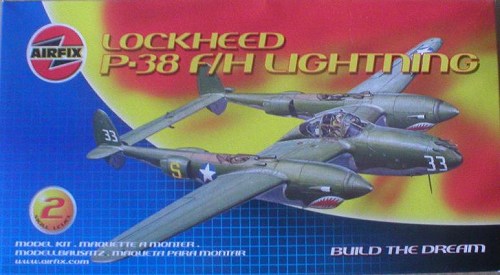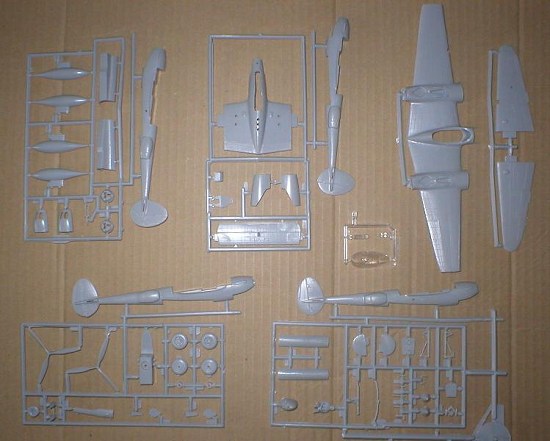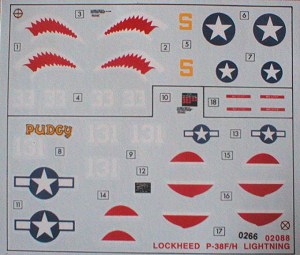
|
KIT: |
Airfix 1/72 P-38F Lightning |
|
KIT # |
02088 |
|
PRICE: |
£2.50 |
|
DECALS: |
Two options |
|
REVIEWER: |
Ant Harrington |
|
NOTES: |
Rivets a'plenty but still recommended |

|
HISTORY |
The Lockheed P38 Lightning was perhaps the most radical fighter design of its day, its unusual twin-boom layout making it almost instantly recognisable. Designed by the great Kelly Johnson in 1937, the XP38 first took to the air in January 1939, a flight that was almost its last. Test Pilot Maj. Ben Kelsey managed to land the aircraft safely despite a serious problem with the flaps that left the aircraft virtually uncontrollable. On February 11th, Kelsey delivered the machine to Wright Field, Ohio and realised he could set a coast-to-coast speed record if he took off again and flew on to Mitchell Field, NY.
The aircraft made it in record time, but was wrecked when it undershot on landing because of a loss of engine power caused by carburettor ice.
Despite this setback, thirteen YP38’s were ordered initially and a further batch of 66 pre-production P38LO’s were ordered before the first YP38 had even been completed. The P38LO was basically an armed and armoured version of the YP38 and was intended for operational evaluation by the USAAC.
The first operational model was the P38D, of which only 36 were built before production moved on to the P38E. The D and E models share the credits for the P38’s ‘first blood’- Lt. Stan Long of the 54th FS shot down a Mavis flying boat over Dutch Harbour in the Aleutians on August 4th 1942 in a P38E, the P38’s first ever kill and Lt. Shahan in a P38D of the 27th FS shared in the destruction of an Fw200 off the coast of Iceland on August 14th, the first Luftwaffe aircraft to fall to the USAAF. These were the first of many P38 victories in a number of theatres.
The F, G and H models were the major early production models and these bore the brunt of the fighting in the Pacific, North Africa and the Mediterranean up until late 1943 when the even further improved J and L models began to arrive on the scene. The P38 and her pilots made a name for themselves as ‘Zero-killers’ in the Pacific and she became known as the ‘Fork-Tailed Devil’ to the Luftwaffe. America’s leading aces Dick Bong and Tommy McGuire both flew P38’s throughout their combat careers.
The F5 reconnaissance model became the mainstay of the USAAF’s strategic recce units in all theatres, the type’s high-altitude performance and agility making the aircraft difficult to intercept.
The P38 was also used by a number of other nations, including Britain who gave the aircraft the Lightning name. These were not real P38’s as they were built specifically for the RAF and differed from standard models in a number of ways, most noticeable of which being the lack of turbo-superchargers. Performance was deemed to be adequate, but with the Westland Whirlwind already in service and the Mosquito on the way it was decided to cancel the RAF’s order in 1942(those already built or under construction were brought up to P38F or G standard and put into USAAF service).
Other wartime users included Russia and Nationalist China, and one Luftwaffe pilot flew a captured P38J in Italy, shooting down perhaps as many as six allied bombers before the aircraft was grounded with mechanical problems.
|
THE KIT |

The kit comes in a lidded box and consists of 64 pieces moulded in light grey plastic with 3 clear parts. The first thing you notice about this kit is the raised rivets, of which there are hundreds all over the place! The P38 was notable for being entirely flush-riveted so these raised ones are not appropriate, but it has to be remembered that this kit dates back twenty years or more and nobody was too bothered about details such as this back then.
The moulding quality is testimony to the age of this kit; there is a significant amount of flash on all the frames and many parts will need to be cleaned up before assembly. Age aside, there are one or two defects which you could say are down more to poor design. The propeller spinners come in front and rear halves, and on inspecting the spinner cones I found they had deep scars caused by ejector pins. These will be quite fiddly to fill and smooth out as the parts are small and of an awkward shape. Another problem is that a number of parts are attached to the frames by joints that are really a bit too substantial; many smaller parts will need to be very carefully handled if they’re not to be damaged when I try to remove them. There are also a large number of raised ejector pin marks, most of which are thankfully on the reverse side of components, but many interfere with the fit of parts and will have to be chiselled away.
There are also one or two detail problems with the kit parts, most notably the wings. The outer wing under-surfaces are moulded with dive-recovery flaps and there is a landing light in the leading edge of the port wing. Both of these features were only introduced from the P38J onwards, so are wrong for this earlier model. The dive-recovery flaps only take the form of raised detail, so it shouldn’t be too difficult to smooth them away, although the adjacent bulged blister (for the hydraulic actuator) is more substantial and will need more attention. I’m hoping the landing light will fit snugly into the wing where it can then be over-painted. Another problem is the lack of detail within the air intakes and radiator housings, so I will have to raid the spares box for some radiator parts and scratch build some intake ducting. The radiator housings also have a solid rear where the outlet and adjustable door should be, so I’ll have to cut these out and replace the doors with some plasticard.
The canopy is moulded to the usual Airfix standard, being rather too thick and difficult to see through, but it’s basically accurate in shape. A number of detail cockpit parts such as radio boxes are included in the kit, and these should be adequate considering the canopy’s distorted clarity.
An interesting feature of this kit is the undercarriage; the mainwheel wells are moulded separately with doors fixed in the open position and another set of doors are included in the kit for the closed option. There is also a nosewheel bay provided, so there are no worries about this model looking ‘hollow’ as some kits of this age do. A nicely detailed nosewheel door is provided separately. The legs and wheels themselves look decent too, with the legs moulded to what look to be the right lengths. This means the finished model should have the correct slightly-tail-down sit when completed.
After successfully dry fitting a
number of components, I compared the form and dimensions of the major
components with the 1:72 scale drawings in the excellent “P38
Lightning In Action” reference book from Squadron/Signal. The kit parts
appear to be pretty much 100% accurate in their general dimensions when
laid on the plans, the only fault being a slight sag on the spines of the
booms above the radiator housings, possibly caused by shrinkage or
distortion after removal from the moulds. For all its smaller detail
errors, this is one kit that looks right and does near full justice to
the P38’s subtle curves and tapers. I’ve seen many Tamigawa kits of the
same and even larger scales that fail to capture the essence of the P38
as this one does, and for less than half the price!
And now, I regret to say, we turn our attention to the decals (horror movie violin riff)! Well, the less said about these the better. Just for the record, the marking options are a shark’s-teeth decorated P38F of the 347thFG on Guadalcanal in February 1943 and ‘Pudgy’, the P38F flown by the ace Tom B. McGuire of the 431st FS, 475thFG in New Guinea late in 1943. The decals are of poor register and are rather thick and ‘crispy’ looking, so I won’t be using them. Airfix’s decals are getting beyond a joke, I can’t understand how they can be satisfied manufacturing them to such a poor standard. I know their decals were never spectacular, but they were at least usable and the same cannot be said for any of the decals I’ve come across over the last three or four years. Looking at some old Airfix decal sheets in my spares box it seems that the ones that have been hanging around for ten years or more are more acceptable than what’s being produced new today! C’mon Airfix, sort yourselves out…
|
CONCLUSIONS |
Well for all it’s smaller detail faults this is a decent kit, particularly when you consider the modest price. I know Academy have just released a new 1:72 P38J, but it depicts a later version and it’s also twice the price of Airfix’s offering. I should mention that I’ve built this Airfix kit before, and I remember it being generally enjoyable to build. On the whole I recommend this kit, although you’ll have some work to do if you want it correct in every detail- get those rivet scrapers out! I’d also recommend that you discard the kit decals and have a hunt around for some replacements as the kit items are simply beyond all hope.
If you would like your product reviewed fairly and quickly by a site that has nearly 250,000 visitors a month, please contact me or see other details in the Note to Contributors.